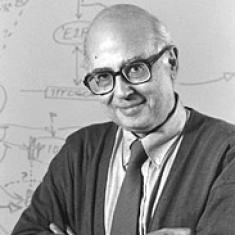Books
Kurt W. Kohn, M.D., Ph.D.

Dr. Kohn received an A.B. degree from Harvard in 1952 with majors in Chemistry and Physics, an M.D. degree from Columbia College of Physicians and Surgeons in 1956, and a Ph.D. in Biochemistry and Molecular Biology from Harvard in 1965. After internship at Mount Sinai Hospital in New York, Kohn came to the National Cancer Institute and served as Clinical Associate in the Clinical Pharmacology Service (headed by Paul Condit) 1957-1960. He then spent 2 years as a graduate student and post-doctoral fellow in Paul Doty's laboratory at Harvard, returning to the NCI in 1962 as a member of the Laboratory of Chemical Pharmacology headed by David P. Rall (this Laboratory was a transformation of the earlier Clinical Pharmacology Service).
In 1968, Kohn founded the Laboratory of Molecular Pharmacology (now the DTP) and served as its Chief until 1997. During this time (1961-1997), Kohn's major area of investigation concerned the mechanisms of action of DNA-targeted anticancer drugs. He demonstrated that bifunctional alkylating agents produce DNA interstrand crosslinks and that this is their major cytotoxic action. He elucidated a new mechanism of drug action on DNA, based on the anthramycin group of antibiotics.
In 1974, he discovered the DNA filter elution phenomenon in which DNA molecules pass through micropore filters at a rate dependent on DNA strand length. Based on these observations, he developed methodology to measure several types of DNA damage in mammalian cells. This methodology was widely used for more than 20 years in many laboratories to study DNA damage and repair in mammalian cells. By DNA filter elution studies, Kohn and his colleagues in 1979-1982 showed that DNA topoisomerases are targets of action of several clinical anticancer drugs. This led to worldwide interest in topoisomerase-targeted drugs that has continued to the present time.
In the 1990's, Kohn and his colleagues began to apply the emerging knowledge of cell cycle checkpoints to study the responses of cancer cells to DNA damage. As an aid to this end, Kohn developed a notation for molecular interaction maps that has recently received considerable interest. In 2015, Dr. Kohn became Scientist Emeritus and continues to collaborate and consult on various DTP projects and with other laboratories.
Drugs Against Cancer: Stories of Discovery and the Quest for a Cure
This book may be viewed as a combination of science, history, medicine, and memoir, and hopefully could mostly be understood without a great deal of prerequisite knowledge. Dr. Kohn has tried to give an account of the earliest published work leading to the anti-cancer drug discovery stories that he will relate. The aim of the book was to explain how the knowledge and application of cancer chemotherapy drugs developed. It is in large part a historical account.
Kurt W. Kohn, MD, PhD
Scientist Emeritus
Laboratory of Molecular Pharmacology
Developmental Therapeutics Branch
National Cancer Institute
Bethesda, Maryland
kohnk@nih.gov
Chapter 1. Anti-cancer drugs that crosslink DNA
Chapter 2. The temozolomide story: DNA-GO6 alkylation and repair
Chapter 3. The Platinum Story: From Imagination to a New Anticancer Drug
Chapter 4. The DNA Intercalation Story: Drug-DNA sandwiches
Chapter 5. The methotrexate story: folic acid analogs
Chapter 6. The 5-Fluorouracil Story: from a simple idea to a major anti-cancer drug
Chapter 7. The 6-mercaptopurine (6MP) story
Chapter 8. The Doxorubicin Story: a star with a nearly fatal flaw
Chapter 9. The DNA filter elution story: a new way to measure DNA damage
Chapter 10. The Topoisomerase II Story: from methodology to a new anticancer drug target
Chapter 11. The Topoisomerase I Story: camptothecin, from a Happy Chinese Tree
Chapter 12. The Mitotic Inhibitor Story: taxol and vinca
Chapter 13. The Bleomycin Story: an anticancer drug with a unique mode of action
Chapter 14. The Philadelphia Chromosome Story and a new era of targeted cancer therapy
Chapter 15. The Oncogene Discovery Story
Chapter 16. The Oncogene Addiction Story: a conceptual basis for cancer therapy
Chapter 17. The EGFR Oncogene story
Chapter 18. The RAS oncogene story
Chapter 19. The BRAF-melanoma story
Chapter 20. Anticancer drug discovery and development at the National Cancer Institute (NCI)
Chapter 21. The DNA Repair Story: early discoveries
Chapter 22. Genetic diseases reveal DNA nucleotide excision repair
Chapter 23. The DNA Nucleotide Excision Repair Story: cutting out the damage
Chapter 24. The DNA Base Excision Repair Story: removing bad bases
Chapter 25. The DNA Mismatch Repair Story: fixing base-pairs that don't match
Chapter 26. The BRCA and homologous recombination story
Chapter 27A. DNA double-strand break repair by homologous recombination
Chapter 27B. DNA double-strand break repair by nonhomologous end joining
Chapter 28. The gamma-H2AX story: DNA double-strand breaks revealed in cell nuclei
Chapter 29. The ataxia telangiectasia story and the ATM gene
Chapter 30. The PARP story and a new strategy for cancer therapy
Chapter 31. The Fanconi anemia story and the repair of DNA crosslinks
Chapter 32. The p53 story - guardian of the genome and the Li-Fraumeni Syndrome
Chapter 33. The retinoblastoma story - control of cell division
This work was produced by the National Cancer Institute, NIH, and the text therein is freely available in the public domain. Many of the figures however have been copied from previously published articles and their further reproduction may require permission from the publishers of the articles in which those figures appeared.

